One of the best ways to eat healthier and, if desired, lose weight is to focus on your daily intake of your fat, protein, and carbohydrate macronutrients (macros) instead of calories.
While manually keeping track of macros is time-consuming and can be difficult, using one of many macro-tracking apps to log your macronutrients makes it easy to manage your daily food diary and helps your overall health goal, including weight loss or gain, muscle gain, and other goals.
As many people embark on new health and fitness journeys, nutrition remains a challenging mystery for some. What are macros? Why are they important?
We’ve listed eight of our favorite free macro-tracking apps to help you kickstart your health and fitness goals this year.
Contents
Suggested readings
- Looking for a cheaper diet app than WW or Noom? Try Healthi (formerly iTrackBites)
- Move Calories vs. Total Calories on Apple Watch. Manage both and stay extra fit
- How to get Strava to calculate and show calories burned?
- The Best Diabetes management apps for your iPhone and Apple Watch this year
- The best food and cosmetic apps for a toxic-free lifestyle
What are macronutrients: The basics
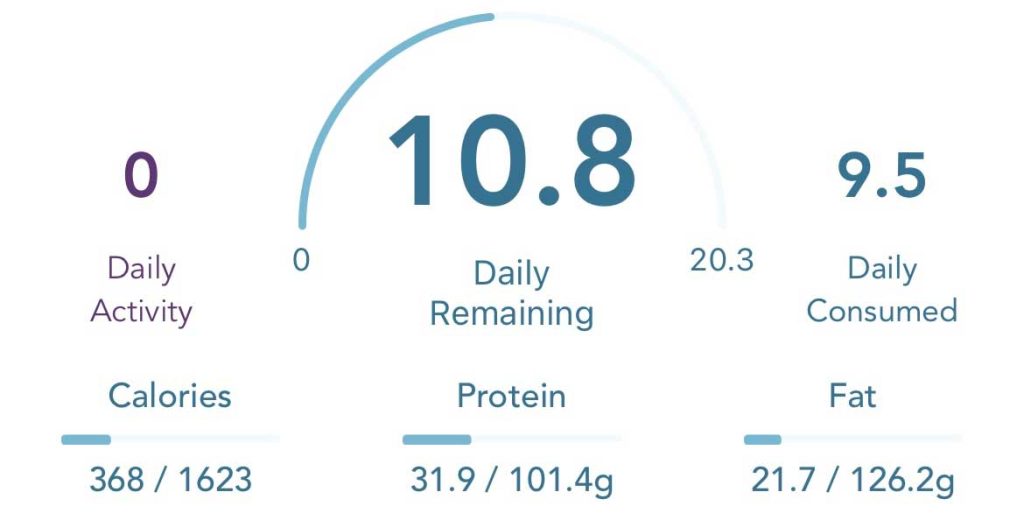
There are three macronutrients (e.g., macros) in our food: carbohydrates, proteins, and fats. These create the core building blocks that supply our body with the needed nutrients to function.
Each gram of the three macros equates to a certain amount of calories (or energy) consumed when you eat a particular food. For example, carbs and proteins contain 4 calories per gram, whereas fats have 9 calories per gram.
Using these numbers, one can determine how many calories are in a particular food and, ultimately, how many calories they consume in a day.
I won’t get into all of the details of how you determine what your basal metabolic rate (BMR) is, but everyone should be aiming to eat a macro-balanced diet.
If you’d like to determine your BMR (and, therefore, how many calories you should eat in a day), check out this macro calculator.
What macro tracking apps should I use?
Once you’ve determined what your macro needs are, it’s time to put those numbers to use and enlist the help of one of many macro tracking apps on the market.
With hundreds to choose from, it’s easy to feel a bit confused or overwhelmed. If you’re also new to the health world, having to pay for an app that you’re uncertain of also doesn’t seem too appealing.
That’s why we’ve created a list of the best free macro tracking apps for you to try. As a bonus, all apps on our list are compatible with iOS and Android.
The best free macro tracking apps to use
While we focus on the free plans, most of these apps offer a paid premium monthly or annual subscription that unlocks additional features.
Although we focus on apps for iPhone and Apple devices, all of these apps also support Android!
Cronometer
Cronometer is the favorite app on our list and for a good reason. It includes a vast food database and a barcode scanner to keep nutrient tracking accurate.
Plus, it syncs with a variety of smart wearables, including Fitbit, Oura, Garmin, and Strava. While there’s a pretty solid free version, there’s also a premium subscription available if you want some extra features, including tracking any fasting and setting goals.
Main features:
- Scan food labels or manually log food into a food diary using Cronometer’s extensive database, including foods from popular restaurants.
- Log exercise, vitamins and supplements, and water intake.
- Track your calories, protein, carbs, cholesterol, and up to 82 different micronutrients.
- Allows you to track body weight and other biometric data, including body measurements, heart and blood pressure data, and blood and urine lab results
- When you first start, you set a goal of gaining, losing or maintaining your current weight. Cronmeter bases your daily targets on this goal.
Pros:
- All user-submitted food and nutrition information to the database is verified by Cronometer’s staff for accuracy
- Helpful graphs make your progress overview easy to see
- Highly customizable
- You can link and sync the app to your fitness wearable and other fitness apps such as the Apple Health app, Fitbit, Garmin, Strava, And Oura
Cons:
- Because it is free, you tend to see a lot of advertisements
- App tends to send a lot of notifications by default (you can change this in Settings > Account > Notifications.)
MyPlate Calorie Tracker
![]()
Main features:
- Create and save customized recipes for easy retrieval in the future
- Calculate daily calories and calories burned from workouts
- Customize daily intake goals for the three main macronutrients
- Log water intake
- View healthy recipes within the app that are tailored to your fitness goals
- Take advantage of the 8-week meal plan created for balanced macros
Pros:
- User-friendly interface
- It can also track micronutrients such as fiber, sugar, and sodium
- Contains mealtime reminders for busy individuals
- It also includes a library of in-app workouts
Cons:
- We really couldn’t find any worth mentioning!
Macros – Calorie Counter
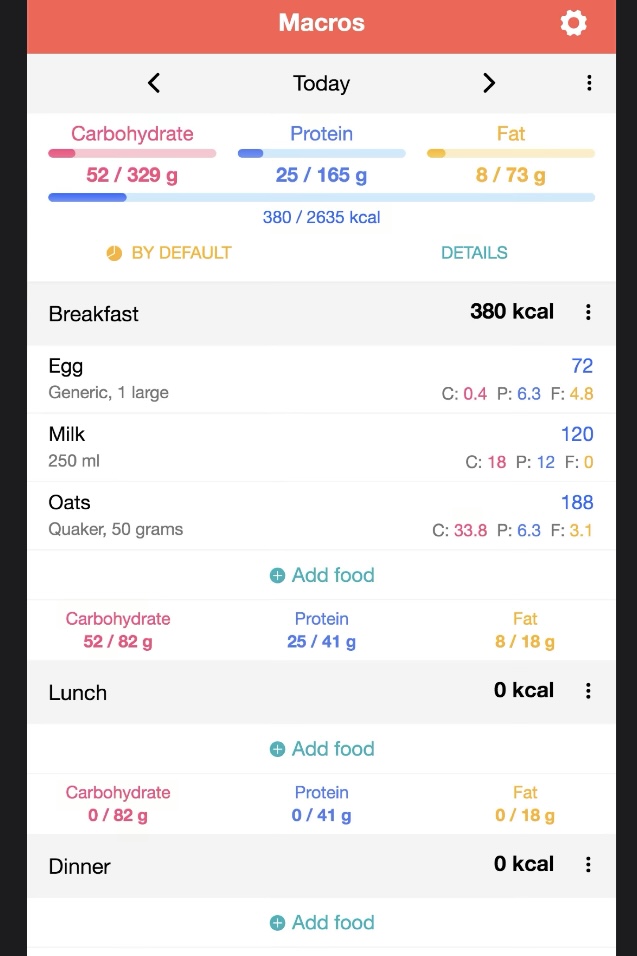
Main features:
- It can help determine your macro requirements to lose weight, gain weight, or build muscle
- Create and save your personal food library of things you eat regularly
- It contains a barcode reader
- Determines daily macro ratios
Pros:
- Color and user-friendly look to the app
- Very easy to navigate
- Highly customizable
Cons:
- Contains advertisements throughout the app
Lose It! – Calorie Counter
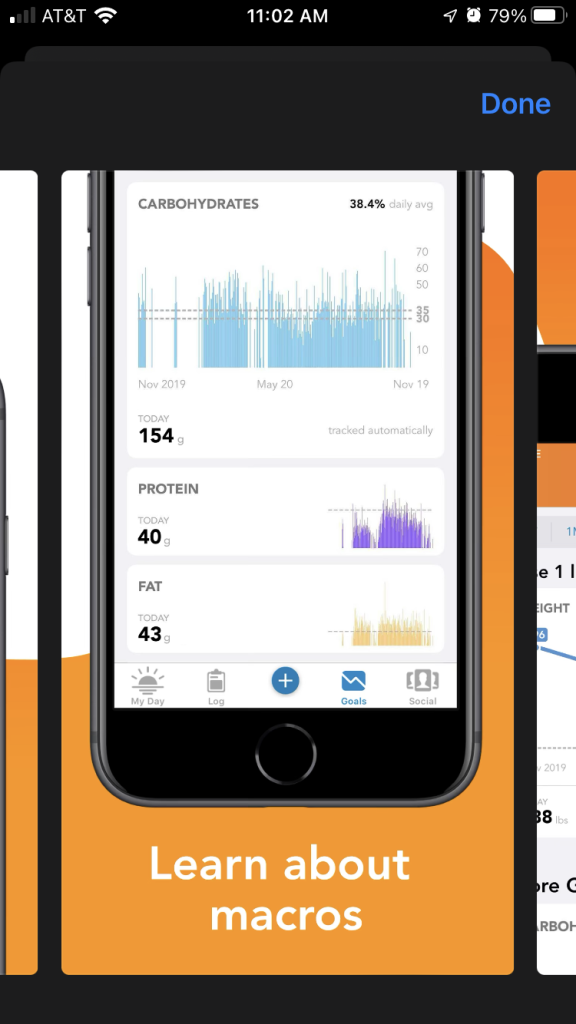
Main features:
- Upload a picture of your meal to aid in carb value estimation
- Customize your diet goals based on popular diets such as keto, vegan, Whole 30, etc.
- It can be synced with other fitness apps to include calories burned from workouts (e.g., Garmin, Fitbit, Google Fit, etc.)
- You can filter its recipe database to include recipes for all types of diets
Pros:
- This macro tracker comes highly reputable with features on The Today Show, Women’s Health, Buzzfeed, and Good Morning America, among others
- Monitor more than just macros: log water intake, sleep cycles, and body measurements
- Appealing design that is easy to use
Cons:
- We couldn’t find any!
Calories Counter by FatSecret
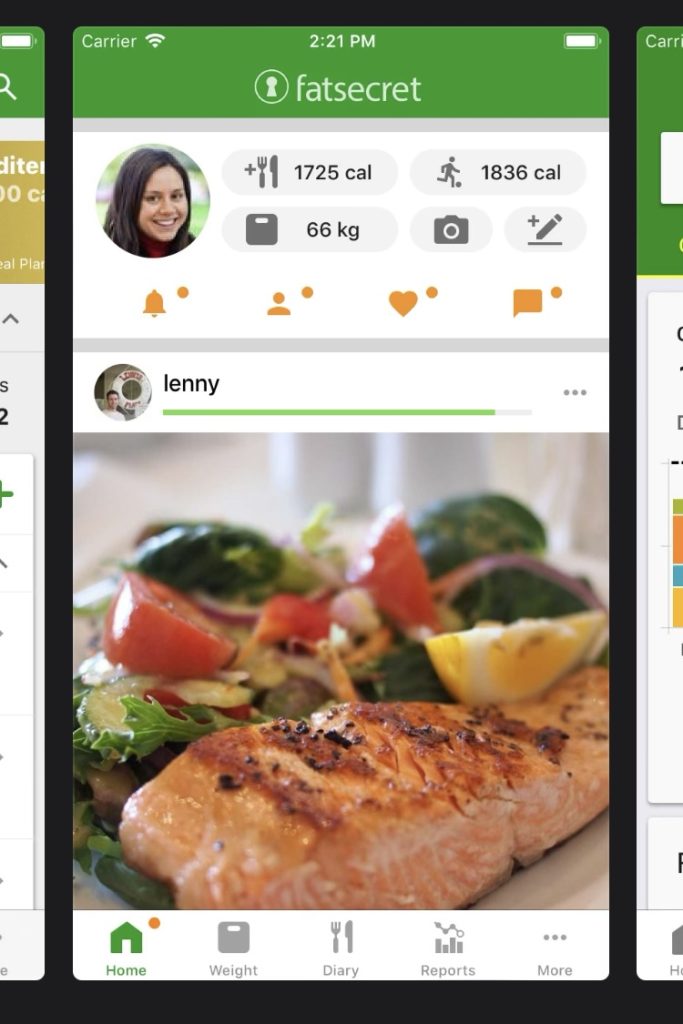
Main features:
- Connect with their health and fitness-oriented community for motivation
- Includes a barcode scanner
- Has both a food diary and exercise diary
- In-app photo album to save your uploaded meals
- Allows you to keep track of calories consumed and calories burned
Pros:
- It contains a database of over 1 million food items with nutritional values
- It has beautiful graphics and food photos
- A plethora of different graphs show progress across different metrics
Cons:
- Some advanced features require you to purchase a premium subscription
Lifesum

Main features:
- Contains customized meal plans, whether it’s keto, paleo, a sugar detox, etc.
- Clear and colorful graphics that highlight your macro ratios, water intake, and total calories consumed
- The app includes a vast library of recipes based on your nutrition goals
- Includes a barcode scanner to log food items easily
Pros:
- Pre-made diet plans to fit your custom macro needs
- Straight-forward and easy to use
- Has won an Apple Editor’s Choice award
Cons:
- Requires a premium membership to gain access to micronutrients, fat ratios, fiber and sugar content, and counting
Carb Manager
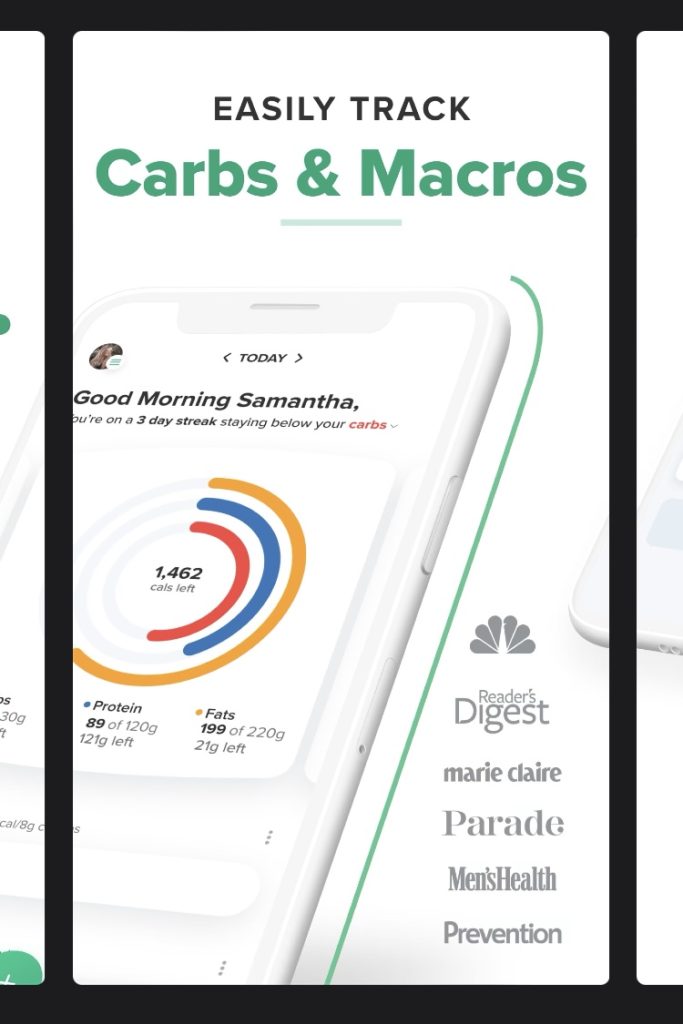
Main features:
- Advertised as the #1 Keto diet app
- Includes both macro-specific and calorie counter
- It also utilizes a weight tracker with BMI calculation
- Nutrient information contains a glycemic index of all recipes
- Log both food and exercise
Pros:
- Log foods with your voice
- Simple and clean interface
- Highly customizable
Cons:
- Requires premium membership to link this app with other fitness devices
MyFitnessPal
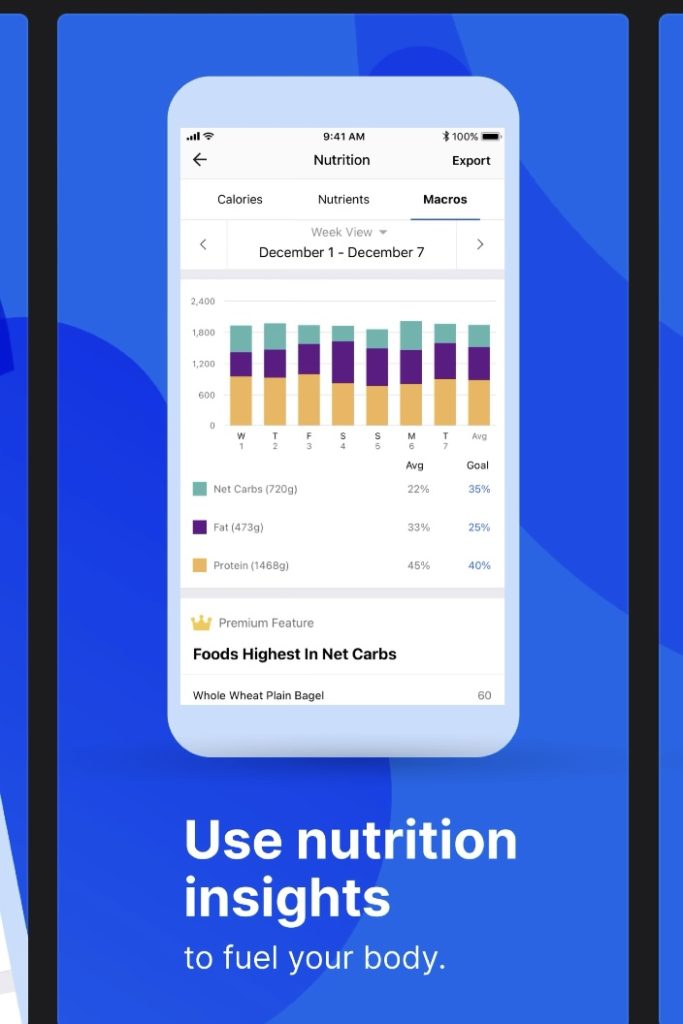
MyFitnessPal (MFP) used to be at the top of the list just under Cronometer, but with recent changes to the app, including eliminating more advanced macro tracking from the free version, it’s now at the bottom.
We’re keeping it on the list because MFP is one of the most popular food-tracking apps.
The free version does include basic macro tracking for carbs, fats, and protein for each day by percentage, and the app translates the percentages into grams for each macronutrient.
MFP automatically sets your macros at 50% carbs, 20% protein, and 30% fat, and you can adjust these percentages in your nutrition goals. Only paid subscription members have the option of setting their macro goals in grams or percentages and settings macro/calorie goals by meal.
Then, as you enter meals and snacks into your food diary, MFP totals how many grams of carbohydrates, fat, and protein you’ve eaten thus far in your day.
Main features:
- Automatically logs calories and macros when you input meals and snacks in your food diary
- Scar barcodes for easy input of your food
- Utilize stored meal plans and recipes within the app
- Connect with over 50 other fitness apps (e.g., Garmin Connect, Fitbit, Apple Health, MapMyRun, etc.)
Pros:
- Customizable
- You can link the app to your fitness wearable and other fitness apps
- One of the largest, well-known apps and communities
Cons:
- Because it is free, it contains a lot of advertisements
- Macro tracking is more basic in the free version
Final thoughts on these free macro tracking apps
These macro tracking apps received very high reviews on the app stores. They all are great options, but some may check more boxes on your list than others.
They all provide you the option of tracking your macros, but they also allow you to log and track a handful of other aspects of your health and fitness.
Hopefully, this article helped to narrow down your search while highlighting some of the best macro tracking apps to use this year.


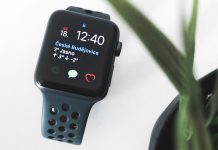
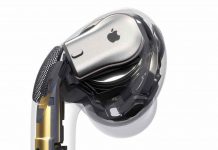



When I checked last week, MyFitnessPal was requiring a subscription in order to track macros.
Hi Barbara,
You can still track macros using the free version of MFP for each day, and it’s a lot more basic than what the premium version offers for macro tracking.
In the free version, you can track macros by day, while the paid version allows you to track macros and calorie goals by meal. With premium, you can also set macro goals by gram or percentage while the free version is percentage only.
To track macros with the free version, go to your dashboard and tap in the Calories area to see Nutrition data. Inside you see tabs for calories, nutrients, and macros. You’ll see your totals for the day thus far. You won’t see a breakdown by meal or by food entered but you will see the accumulated total by percentage and grams of your macros protein, carbs, and fats along with other nutrient information.
No Cronometer mention? The free version is more feature dense than a handful of the ones listed here.